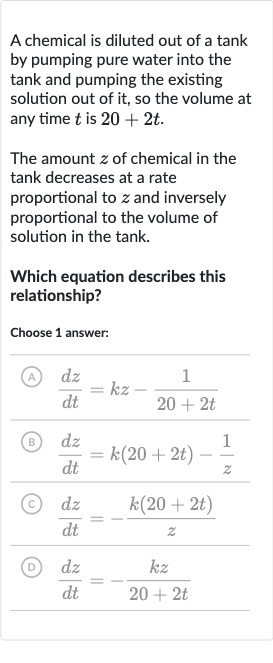AI tutor
Welcome to Bytelearn!
Let’s check out your problem:

A chemical is diluted out of a tank by pumping pure water into the tank and pumping the existing solution out of it, so the volume at any time is .The amount of chemical in the tank decreases at a rate proportional to and inversely proportional to the volume of solution in the tank.Which equation describes this relationship?Choose answer:(A) (B) (c) (D)
Full solution
Q. A chemical is diluted out of a tank by pumping pure water into the tank and pumping the existing solution out of it, so the volume at any time is .The amount of chemical in the tank decreases at a rate proportional to and inversely proportional to the volume of solution in the tank.Which equation describes this relationship?Choose answer:(A) (B) (c) (D)
- Identify Proportional Relationship: The problem states that the rate of decrease of the chemical is proportional to and inversely proportional to the volume of the solution in the tank, which is . This means that the rate of change of with respect to time , denoted as , should be equal to a constant times , and divided by the volume . This gives us the equation , where the negative sign indicates that is decreasing.
- Derive Rate Equation: We can now compare the derived equation with the given options to find the correct answer.Option (A) does not match our derived equation because it suggests that the rate of decrease is not inversely proportional to the volume.
- Compare with Options: Option (B) also does not match our derived equation because it suggests that the rate of decrease is directly proportional to the volume, which is not the case.
- Match with Correct Option: Option (C) does not match our derived equation because it suggests that the rate of decrease is inversely proportional to , which is not the case.
- Match with Correct Option: Option (C) does not match our derived equation because it suggests that the rate of decrease is inversely proportional to , which is not the case.Option (D) matches our derived equation perfectly, indicating that the rate of decrease of the chemical is proportional to the amount of chemical and inversely proportional to the volume .
More problems from One-step inequalities: word problems
QuestionGet tutor help
QuestionGet tutor help
QuestionGet tutor help
QuestionGet tutor help
QuestionGet tutor help
QuestionGet tutor help
QuestionGet tutor help
QuestionGet tutor help
QuestionGet tutor help
QuestionGet tutor help
